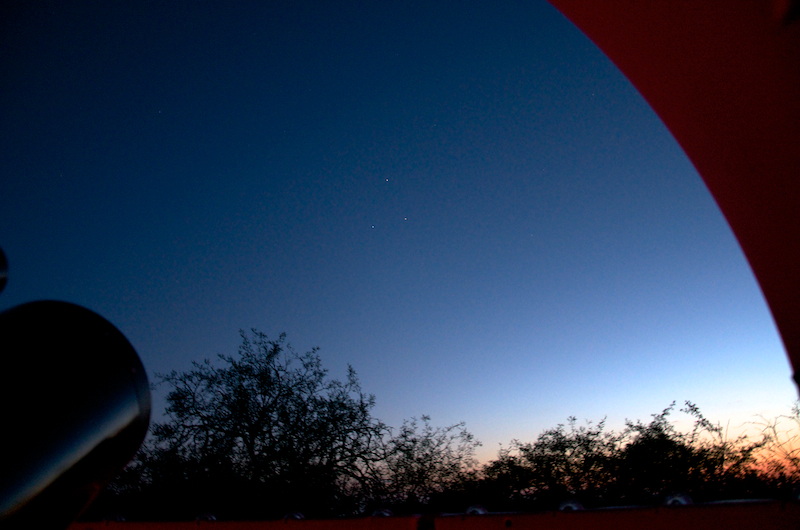
Saturn/Spica/Mars; NGC6804 Planetary Nebula
Posted: 10 August 2012
After the clouds returned during my last session on Friday, 3 August 2012, cloudy skies were the norm. Had some rain sprinkles on Sunday, 5 August. Late Wednesday afternoon, 8 August, a strong monsoon thunderstorm passed just west of the observatory. Lots of Cloud-To-Ground (CTG) lightning and heavy rain. But very little rain at the observatory (0.12"). A time-lapse video from my live webcam is available. Just prior to sunset (of course), this rainbow appeared (panorama using Microsoft's free Photosynth iOS app):

Finally, the sky cleared on Thursday, 9 August. As I approached the observatory with the sun setting, I took this photo of the western sky:

The observatory was opened at 1912 MST, 100°F. At 1921 MST, viewed Saturn at 77X and 133X. At 1935 MST (about 20 minutes after sunset), Saturn, Spica, and Mars were visible to the naked eye. They all were easily within the field-of-view of my 7x50 binoculars; lovely view. At 1942 MST, took a look at Mars, 133X. Seeing was not good and no details were visible on the planet's disk, but this was my first opportunity to view Mars since the rover Curiosity landed in Gale Crater.
At 1948 MST, slewed to M57, which was my intended imaging target for the night. It was just barely visible at 133X against the twilight sky. It was near the zenith and I would likely have to wait until it was west of the zenith before I could image it.
At 1953 MST, I took this handheld photograph of Saturn, Spica, and Mars, f/3.5, 1/2sec, 18mm, ISO 500:

Compare the positions of the planets and star with the photograph on my last report.
Some small clouds were visible near the Milky Way at 2008 MST. I slewed to NGC6804, a small, faint (Magnitude +12), planetary nebula. At 2012 MST, it became faintly visible in the still-bright sky using 77X. Since the clouds seemed to be increasing, I decided to image NGC6804 while it was clear in that part of the sky. I attached the D7000 DSLR at prime focus of the 8" LX200-ACF using the Off-Axis Guider. I used the ShutterBoss wireless control for shutter control. I slewed to the star Altair, SYNCed on it, and did a focus test using the Bahtinov Mask. At 2037 MST, I took this guided, 1 minute, ISO 6400, exposure (cropped from the full-frame image):

By 2050 MST, clouds were now visible in the northern sky; Cassiopeia was almost invisible. I slewed to M57; I would definitely need to wait until it was west of the zenith. (I really need to consider getting a POD Zenith Table.)
At 2056 MST, saw a Perseid meteor. As I was checking the sky for clouds, I happened to notice this large spider on the observatory wall:

At 2111 MST, saw a non-Perseid meteor. Clouds were now in the north and east. I decided to end the session. By 2122 MST, clouds were now in the southeastern sky as well.
Closed the observatory at 2133 MST, 84°F. Although the session was shortened by the clouds, it was great to be back in the observatory again after six days.
Comments are welcome; use the Comments section below, or you can Email Me. Thanks.
Go to the previous report.
Return to the Cassiopeia Observatory Welcome Page.